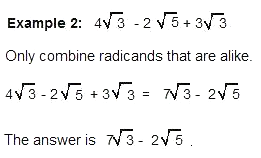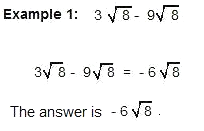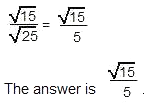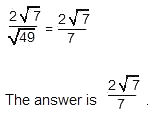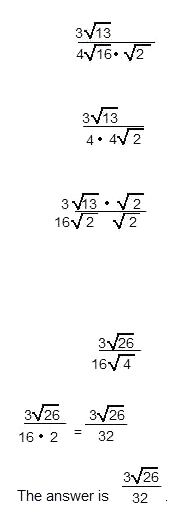- Find the square root of the radicand.
- Leave no radical in the denominator.
- Simplify.
Some Helpful Tools
This section will cover the fundamentals and rules of simplifying radical expressions.
Simplifying Radical Expressions
A radical is simplified when:
- no radicand has a square factor other than 1,
- there are no fractions under the radical sign,
- and no radical is left in the denominator.
A radical expression does not contain an equal sign when it is orginally written. However, when it is simplified, it is written with an equal sign to show the simplified result.
Examples:
Adding Radical Expressions
- Combine the radicands.
- Add radicals with like radicands.
- Simplify.
Steps for adding radical expressions:
Subtracting Radical Expressions
- Combine the radicands.
- Subtract radicals with like radicands.
- Simplify.
Steps for subtracting radical expressions:
Find two numbers that when multiplied
together will give you 50. One has to be
a perfect square.
The square root of 25 is 5. The 5 comes
out from the radical sign.
This creates two like radicands.
Multiply 5 times 3.
Subtract 4 from 15.
Multiplying Radical Expressions
Since the radicands are the same, you can
subtract -9 from 3.
- Find the square root of the radicand.
- Factor the non-perfect square roots.
- Remove the perfect squares out from under the radical sign.
- Simplify.
Steps for multiplying radical expressions:
Factor 63.
Since the square root of 9 is 3, bring the 3 out from under the radical sign.
Example 2:
Factor 32.
Since the square root of 16 is 4, bring the 4 out from under the radical sign.
Multiply 6 x 4.
Dividing Radical Expressions
Steps for dividing radical expressions:
The square root of 25 is 5.
Remove the radical sign in the denominator by multiplying the numerator and the denominator times the radical to create a perfect square.
Remove the radical sign in the denominator by multiplying the numerator and the denominator times the radical to create a perfect square.
The square root of 49 is 7.
Factor 32.
The square root of 16 is 4.
Bring the 4 out from under the radical sign.
Multiply 4 x 4.
Remove the radical sign in the denominator by multiplying the numerator and the denominator times the radical to create a perfect square.
The square root of 4 is 2.
Multiply 2 x 16.
Since 3 and 32 cannot be reduced, it is in its simplest form.
Math: Radical Expressions - Tutorial








